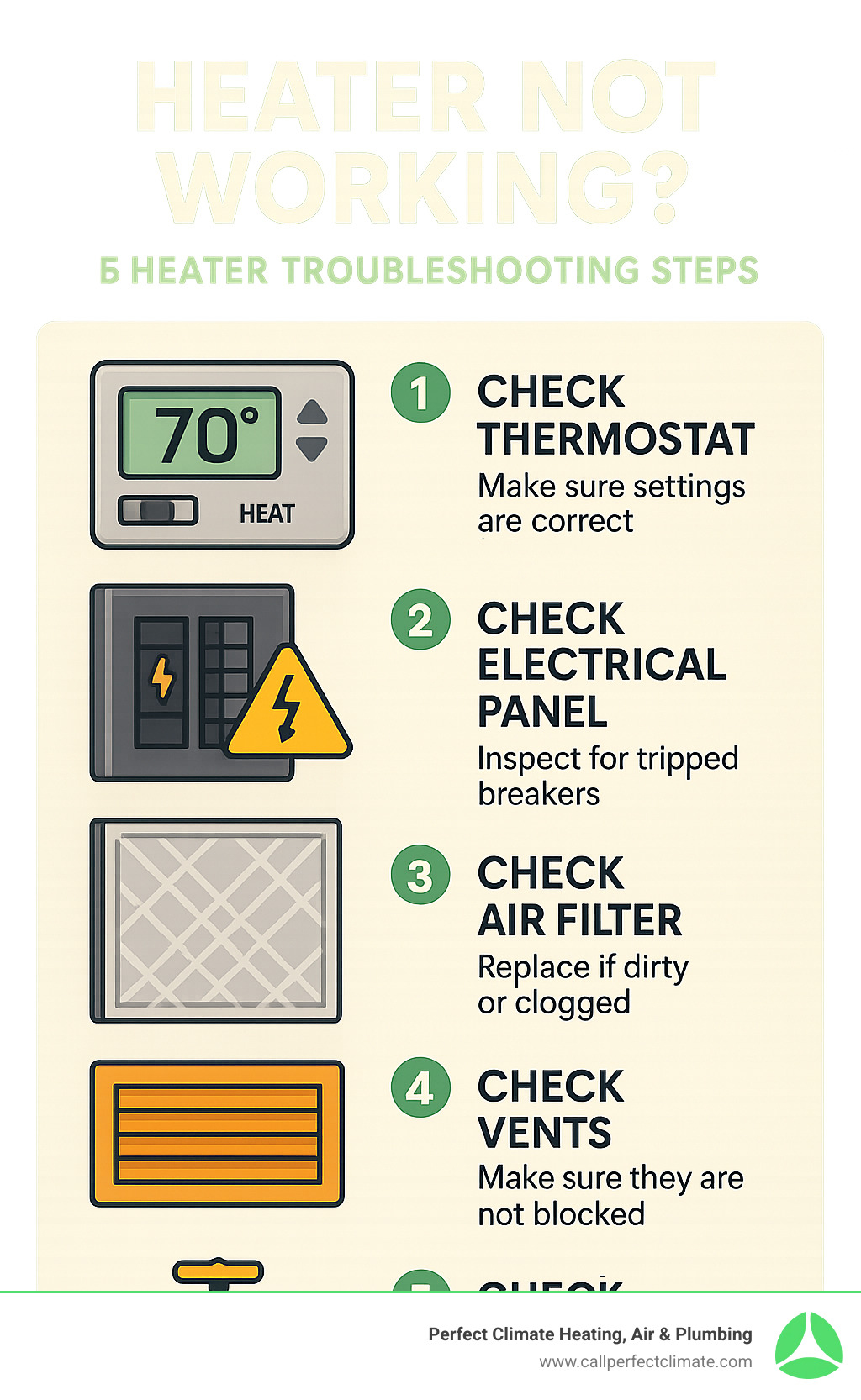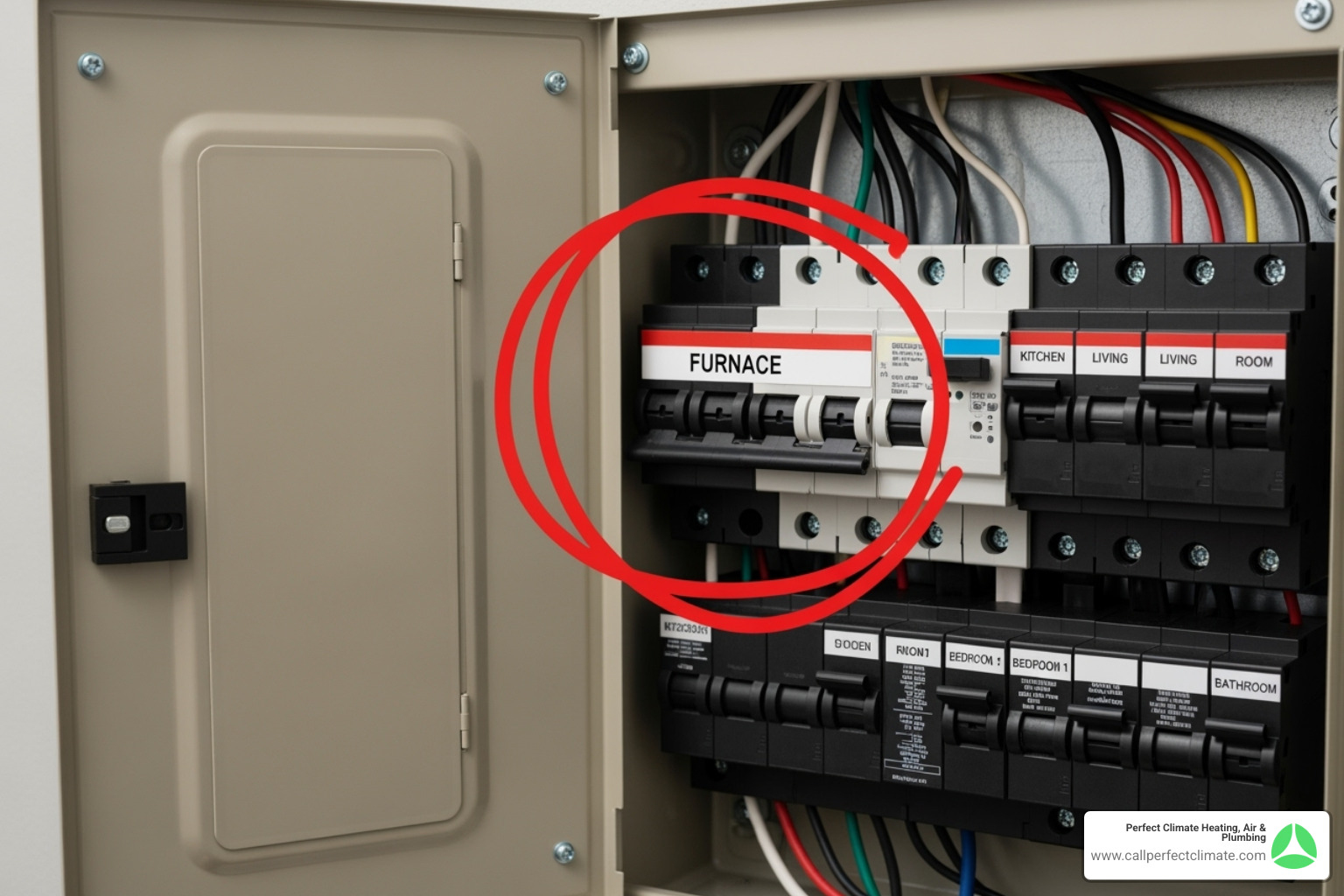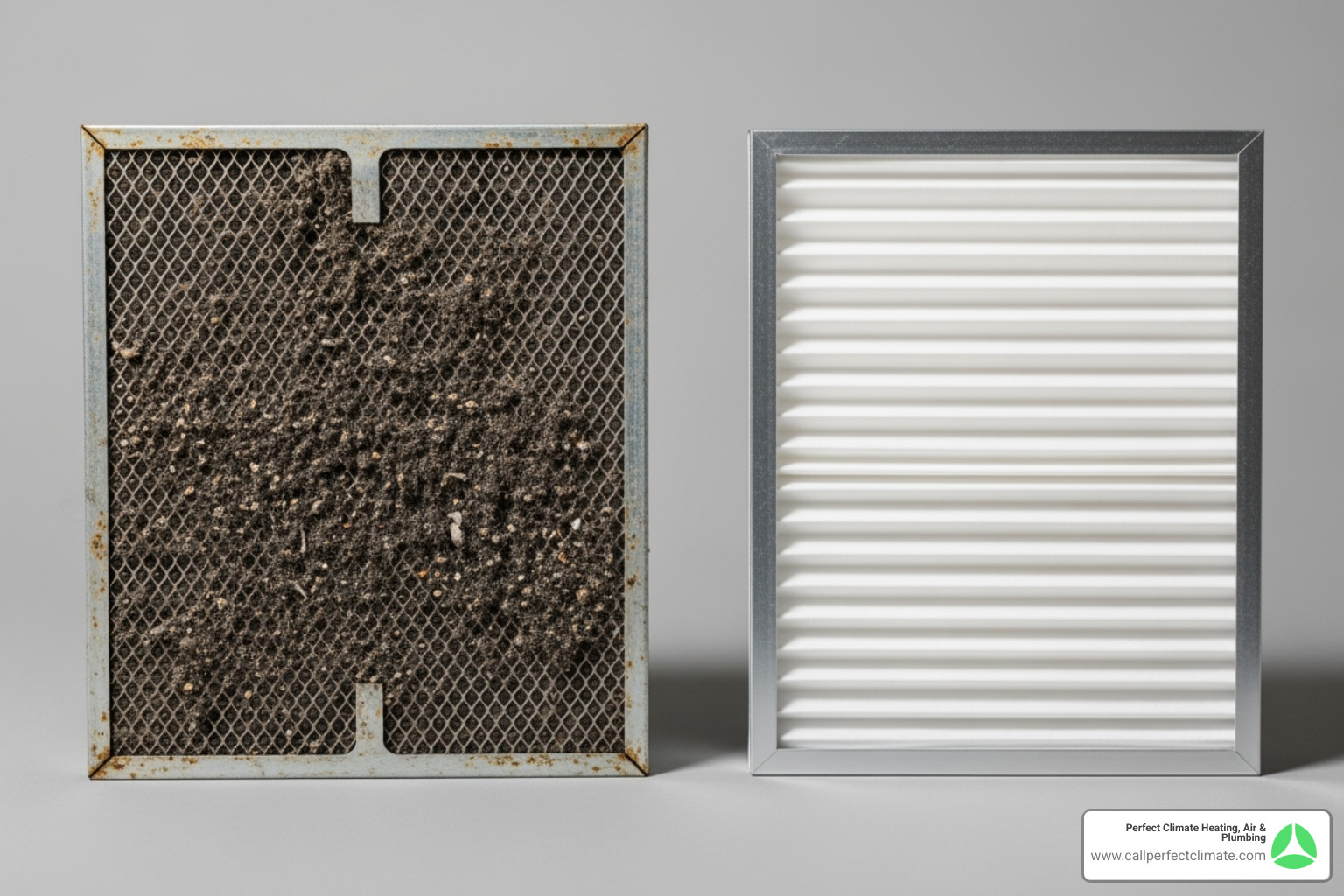When Your Heater Stops Working: Quick Solutions for Cold Homes
When your heater not working leaves you shivering indoors, you need answers fast. Here’s what to check first:
Immediate Steps to Take:
- Check your thermostat – Make sure it’s set to “Heat” and 5°F above room temperature
- Verify power supply – Look for tripped breakers or blown fuses
- Inspect your air filter – A clogged filter can shut down your entire system
- Check all vents – Ensure they’re open and unblocked
- Confirm fuel supply – For gas furnaces, verify the gas valve is on
Most heater problems stem from simple issues that homeowners can fix themselves. A dirty air filter alone accounts for many heating failures, as it restricts airflow and causes the system to overheat and shut down as a safety measure.
Safety comes first. If you smell gas, hear unusual noises, or suspect electrical problems, turn off your system immediately and call a professional. According to the National Fire Protection Association, heating equipment accounted for 14% of home fires between 2014 and 2018, making proper troubleshooting and maintenance crucial for your family’s safety.
The good news? Many “broken” heaters just need basic attention. Before calling for expensive repairs, a few simple checks can often restore warmth to your home within minutes.
First Steps: Simple DIY Checks When Your Heater Isn’t Working
It’s a classic scenario: the temperatures drop, you crank up the heat, and… nothing. A heater not working is certainly frustrating, but before panic sets in, let’s walk through some initial troubleshooting steps. You might be surprised at how often a common issue has a simple fix, requiring no special tools or professional assistance. We’ve found that many “repairs” are simply a matter of turning the furnace on or adjusting a setting!
Checking Your Thermostat
Your thermostat is the brain of your heating system. If it’s not communicating properly, your heater won’t know what to do. Here’s how to check it:
- Set to “Heat”: This might sound obvious, but we’ve all been there! Ensure your thermostat is set to “Heat” mode, not “Off” or “Cool.” If it’s a programmable thermostat, double-check that the program isn’t set to a “hold” or “away” setting that prevents it from heating. Sometimes, after a power outage, programmable thermostats can revert to default settings or lose their programmed schedule.
- Temperature Setting: Is the desired temperature set higher than the current room temperature? Your heater won’t kick on if it thinks your home is already warm enough. Try raising the temperature by 5-10 degrees to see if that prompts a response.
- Battery Replacement: For battery-operated thermostats, dead batteries are a surprisingly common culprit. If the display is blank or dim, or if the thermostat isn’t responding, try replacing the batteries. We recommend changing them annually as a preventative measure.
- Clean Contacts: Dust or debris can sometimes interfere with the thermostat’s internal contacts. While we don’t recommend opening the thermostat unless you’re comfortable, a gentle tap might dislodge something.
- Check Programming: If you have a programmable thermostat, ensure its schedule aligns with your heating needs. A “silent saboteur” can be a faulty thermostat, preventing your system from receiving the correct signals.
- Signs of a Faulty Thermostat: Beyond a blank display or lack of response, signs of a faulty thermostat include inconsistent heating (some rooms too hot, others too cold), the heater constantly running, or the heater short-cycling (turning on and off too frequently).
Verifying Power to the Furnace
No power, no heat. Electrical issues are often overlooked culprits for heating failure. Your furnace needs a steady supply of electricity to operate its fan, controls, and ignition system.
- Tripped Circuit Breaker: Head to your home’s electrical panel (usually in the basement, garage, or utility closet). Look for a tripped breaker – it will typically be in the “off” position or somewhere between “on” and “off.” Flip it firmly to “off” and then back to “on.” If it immediately trips again, there’s a more serious electrical issue, and you should call a professional.
- Blown Fuse: Older homes might have a fuse box instead of a breaker panel. If a fuse is blown, it will look discolored or have a broken filament. Replace it with a new fuse of the same amperage.
- Furnace Power Switch: Most furnaces have a dedicated power switch, often located on or near the unit itself, resembling a light switch. Make sure it’s in the “on” position. Sometimes, it gets accidentally switched off, especially if it’s near a light switch.
- Emergency Shutoff: Some heating systems have an emergency shutoff switch, often at the top of the basement stairs or in a utility room. Ensure this hasn’t been flipped.
- Electrical Panel Check: While you’re at the electrical panel, make sure all other relevant breakers (like for the blower motor or other HVAC components) are also in the “on” position.
Common Causes for a Heater Not Working and How to Fix Them
Now that we’ve covered the basics, let’s dive into the most common culprits behind a heater not working. The good news? Many of these issues are surprisingly straightforward to fix, and you probably already have everything you need to tackle them. Most heating problems boil down to three main areas: airflow restrictions, fuel supply hiccups, and ignition troubles.
Think of your heating system like your body’s circulatory system – it needs clear pathways for air to flow, a reliable fuel source, and a spark to get things going. When any of these elements gets disrupted, your whole system can come to a grinding halt.
Airflow Issues: Filters, Vents, and Ducts
Your heating system is basically a really expensive fan that also happens to warm air. But if that air can’t flow freely, your heater not working properly becomes inevitable. It’s like trying to breathe through a straw – eventually, something’s got to give.
Dirty air filters are the number one villain in heating failures. We can’t stress this enough: a clogged filter doesn’t just make your system work harder, it can actually force your furnace to shut down completely as a safety measure. When airflow gets restricted, your heat exchanger overheats faster than a car engine without coolant.
Check your filter monthly during heating season – it should look clean enough that you can see light through it. If it looks like it’s been through a dust storm, it’s time for a replacement. The arrow on the filter should always point toward the furnace, and most homes need a fresh filter every one to three months.
Blocked vents and registers are another sneaky problem. Take a walk through your house and check every heating vent. Is furniture pushed up against them? Are curtains draped over them? Kids have a talent for dropping toys into floor vents, and pets love to claim heating vents as their personal warming stations.
Leaky ductwork is like having holes in your garden hose – all that heated air you’re paying for ends up warming your attic or crawl space instead of your living room. While you can tackle small, accessible leaks with metallic duct tape (not the cloth kind!), extensive ductwork problems need professional attention.
The importance of yearly maintenance can’t be overstated here. According to Energy Star, regular maintenance keeps your system running efficiently and catches problems before they leave you shivering in the dark.
Fuel & Ignition Problems in Gas Furnaces
Gas furnaces need two things to work: gas and something to light it with. When either goes missing, you’re left wondering why your heater not working is ruining your cozy evening plans.
Pilot light problems are common in older furnaces. If your pilot light is out, your furnace is basically a very expensive paperweight. Before attempting to relight it, wait at least 10-15 minutes for any lingering gas to clear – this isn’t the time to rush things. Follow the instructions on your furnace’s access panel, which usually involve turning the gas valve to “pilot,” holding down a reset button, and carefully lighting with a long match or lighter.
Modern furnaces use electronic ignition systems instead of constantly burning pilot lights. These are more efficient, but they can fail too. A faulty ignitor that’s cracked or broken won’t create the spark needed to light the gas. You’ll hear clicking sounds as your furnace tries repeatedly to ignite, like a car that won’t start.
The dirty flame sensor is a particularly frustrating problem because your furnace will actually light – for about 10 seconds. Then it shuts off, tries again, lights briefly, and shuts off again. This safety device needs to “see” the flame to keep the gas flowing, but if it’s dirty, it can’t do its job. Gently cleaning it with fine-grit sandpaper often solves this maddening cycle.
Don’t forget to check your gas valve – it should be parallel to the gas pipe when open. If other gas appliances in your home aren’t working either, you might have a broader gas supply issue that needs professional attention.
Blocked flue pipes create a serious safety hazard. Your furnace won’t operate if it can’t safely vent combustion gases outside. Birds, debris, or ice can block these pipes, triggering safety switches that shut down your system to prevent carbon monoxide buildup.
Why Your Heater is Blowing Cold Air or Short Cycling
Nothing’s quite as disappointing as feeling your heating system kick on, only to get blasted with cold air. Or maybe your furnace has developed a case of indecision, turning on and off more frequently than a teenager changing their mind about weekend plans.
Incorrect fan settings are often the culprit behind cold air mysteries. If your thermostat’s fan is set to “On” instead of “Auto,” it runs continuously, pushing unheated air through your vents even when the furnace isn’t actively heating. Switch it to “Auto” and see if that solves your chilly problem.
Overheating and limit switches create a frustrating scenario where your furnace starts heating, then shuts off the burners while leaving the fan running. This safety feature prevents damage, but it means you get cold air until the system cools down enough to try again. Usually, this points back to airflow problems we discussed earlier.
Heat pump specific issues add another layer of complexity. If you have a heat pump and it’s blowing cold air, low refrigerant might be the problem. Heat pumps don’t create heat – they move it from outside to inside. Without enough refrigerant, this heat transfer process breaks down, leaving you with expensive cold air.
Short cycling – when your system turns on and off too frequently – often stems from a dirty flame sensor, improper thermostat placement, or airflow restrictions. A thermostat placed near a draft, in direct sunlight, or next to a heat source will give false readings, confusing your system about when to run.
The key to most of these problems? Regular attention and maintenance. A little prevention goes a long way toward keeping your home warm and your heating bills reasonable.
Advanced Diagnostics: When to Suspect a Deeper Problem
Sometimes the simple fixes don’t work, and your heater not working points to something more serious lurking beneath the surface. These aren’t the kinds of problems you can solve with a screwdriver and a YouTube video – they require professional expertise and specialized tools.
When your heating system starts making strange noises, produces unusual odors, or behaves erratically despite your best troubleshooting efforts, it’s time to dig deeper. These symptoms often indicate failing internal components or, in worst-case scenarios, serious safety hazards that could put your family at risk.
Common Electrical Component Failures
Your heating system relies on several electrical components working in harmony. When one fails, the whole orchestra falls apart, leaving you in the cold.
The blower capacitor is like the starter motor in your car – it provides that initial electrical boost to get the blower motor spinning. When it fails, you’ll hear a telltale humming sound from your furnace, but no air will move through your vents. It’s essentially your furnace trying to start but can’t quite get going.
Your blower motor itself can also give up the ghost after years of faithful service. This is the workhorse that pushes heated air through your ductwork and into your rooms. When it fails, your furnace might heat up just fine, but all that lovely warm air stays trapped inside the unit instead of reaching you.
The control board acts as your furnace’s brain, coordinating signals between all the different components. When it burns out or gets damaged, your heating system can behave unpredictably – sometimes working perfectly, other times shutting down for no apparent reason. It’s like having a conductor who occasionally forgets which symphony they’re conducting.
A faulty transformer cuts off communication between your thermostat and furnace by failing to convert your home’s standard voltage to the lower voltage your furnace’s controls need. Without this voltage conversion, your furnace simply won’t respond when you adjust the thermostat, no matter how dramatically you twist the dial.
The run capacitor helps your blower motor maintain steady operation once it gets going. When it fails, your motor might struggle to maintain proper speed, leading to weak airflow and inefficient heating.
Signs of electrical failure go beyond simple non-operation. Humming noises, burning smells, or systems that work intermittently all point to electrical issues that require professional diagnosis and repair.
Serious Safety Hazards and System-Specific Issues
Some heating problems transcend mere inconvenience and enter dangerous territory. These are the issues that can literally be life-threatening if not addressed immediately by qualified professionals.
A cracked heat exchanger represents the most serious furnace problem you can encounter. This component separates the combustion gases from the air that circulates through your home. When it develops cracks, deadly combustion gases – including carbon monoxide – can leak into your living spaces.
Carbon monoxide poisoning is particularly insidious because the gas is completely odorless, colorless, and tasteless. Early symptoms like headaches, dizziness, nausea, and fatigue are easily mistaken for common flu symptoms. By the time you realize what’s happening, it might be too late.
Watch for warning signs of a cracked heat exchanger: a strong, unusual chemical odor resembling formaldehyde, soot buildup inside your furnace, or a yellow or flickering burner flame instead of the normal steady blue flame. You might also notice rust or corrosion on your furnace, or household members experiencing frequent headaches and nausea.
If you suspect a cracked heat exchanger, take immediate action. Turn off your furnace, open windows for ventilation, and evacuate your home. Don’t return until a qualified professional has thoroughly inspected your system and given you the all-clear.
Heat pump systems face their own unique challenges. Low refrigerant levels directly impact a heat pump’s ability to transfer heat effectively, usually resulting from leaks that require professional repair and system recharging.
Heat pumps also deal with defrost mode issues during cold weather. These systems periodically reverse their operation to melt ice buildup on the outdoor coil. When this defrost cycle malfunctions, ice can completely encase the outdoor unit, rendering it useless for heating.
Signs of heat pump problems include excessive ice buildup on the outdoor unit when it’s not actively defrosting, unusual grinding or squealing noises, or your auxiliary heat running constantly – which defeats the energy efficiency that makes heat pumps attractive in the first place.
Blower motor problems affect both furnaces and heat pumps. Whether caused by motor failure, capacitor issues, or control board malfunctions, a non-functioning blower means no air circulation – and no comfort for your family.
These advanced problems require the expertise that comes from years of training and experience. At Perfect Climate, we’ve seen it all in homes throughout Haubstadt, Evansville, Princeton, Newburgh, and the surrounding Indiana communities. When simple troubleshooting doesn’t solve your heating woes, it’s time to call in the professionals who can safely diagnose and repair these complex issues.
DIY vs. Calling a Pro: Knowing Your Limits
We get it – there’s something satisfying about fixing things yourself, and when your heater not working leaves you in the cold, the urge to dive in and solve the problem is strong. The good news is that many heating issues really can be tackled by homeowners with a bit of know-how and confidence.
Simple fixes you can handle yourself include checking and replacing thermostat batteries, making sure your thermostat is actually set to “Heat” (we’ve all been there!), resetting tripped circuit breakers, and replacing dirty air filters. You can also clear blocked vents and registers, check that your furnace power switch is on, and even relight a pilot light on older gas furnaces if you follow the instructions carefully.
For basic maintenance like cleaning a flame sensor, a gentle touch with fine-grit sandpaper can often solve short-cycling issues. These tasks require nothing more than common household tools and a careful approach.
But here’s where things get serious. Some repairs cross into territory where professional expertise isn’t just recommended – it’s essential for your safety. Diagnosing and repairing internal electrical components like control boards, blower motors, or transformers requires specialized knowledge and tools. Working with refrigerant in heat pumps isn’t just complex; it requires certification and proper equipment.
The biggest safety concern? A cracked heat exchanger. This isn’t just a repair issue – it’s a potential carbon monoxide hazard that could endanger your family’s lives. Similarly, persistent gas supply issues, gas leaks, or extensive ductwork problems need professional attention immediately.
Think about warranty protection too. Many manufacturers require licensed contractors to perform repairs to keep your warranty valid. Attempting complex DIY repairs might save money upfront but could cost you thousands if something goes wrong and your warranty is voided.
The real secret to avoiding emergency repairs? Regular professional maintenance. A yearly tune-up in the fall catches small problems before they become big, expensive ones. Our team at Perfect Climate performs thorough inspections, cleaning, and calibration that keeps your system running efficiently and safely all winter long.
When basic troubleshooting doesn’t solve your heating problems, or if you encounter anything that makes you uncomfortable safety-wise, that’s your cue to call in the experts. Our experienced technicians at Perfect Climate Heating, Air & Plumbing have the knowledge and specialized equipment to handle everything from complex electrical failures to advanced geothermal and solar systems throughout Haubstadt, Evansville, Princeton, Newburgh, and all of Indiana.
Conclusion
When your heater not working leaves you bundling up in blankets inside your own home, you’re not powerless. We’ve walked through the essential troubleshooting steps together – from checking that thermostat setting (we’ve all been there!) to inspecting air filters and verifying power connections. These simple checks can often restore warmth to your home in just minutes.
Start with the basics every time. Check your thermostat settings, look for tripped breakers, examine your air filter, and ensure all vents are open and unobstructed. Many homeowners are surprised to find their “broken” heater just needed a fresh filter or a flipped switch.
But here’s what matters most: your family’s safety comes first. If you smell gas, hear strange grinding or banging noises, or suspect problems like a cracked heat exchanger, don’t hesitate. Turn off your system immediately and call for professional help. Some repairs simply aren’t worth the risk of attempting yourself.
The real secret to avoiding those middle-of-winter heating emergencies? Preventative maintenance is your best friend. Annual tune-ups catch small issues before they become big, expensive problems. Think of it like getting a check-up at the doctor – a little prevention goes a long way toward avoiding major troubles down the road.
When your DIY efforts have reached their limit, or when you’d rather leave it to the experts from the start, we’re here for you. Our team at Perfect Climate Heating, Air & Plumbing understands how stressful a heating breakdown can be, especially during Indiana’s coldest months. We’re committed to getting your home comfortable again quickly and safely.
Schedule your heating repair in Princeton, IN or anywhere in our service area, and let us handle the heavy lifting while you get back to enjoying a warm, cozy home.




